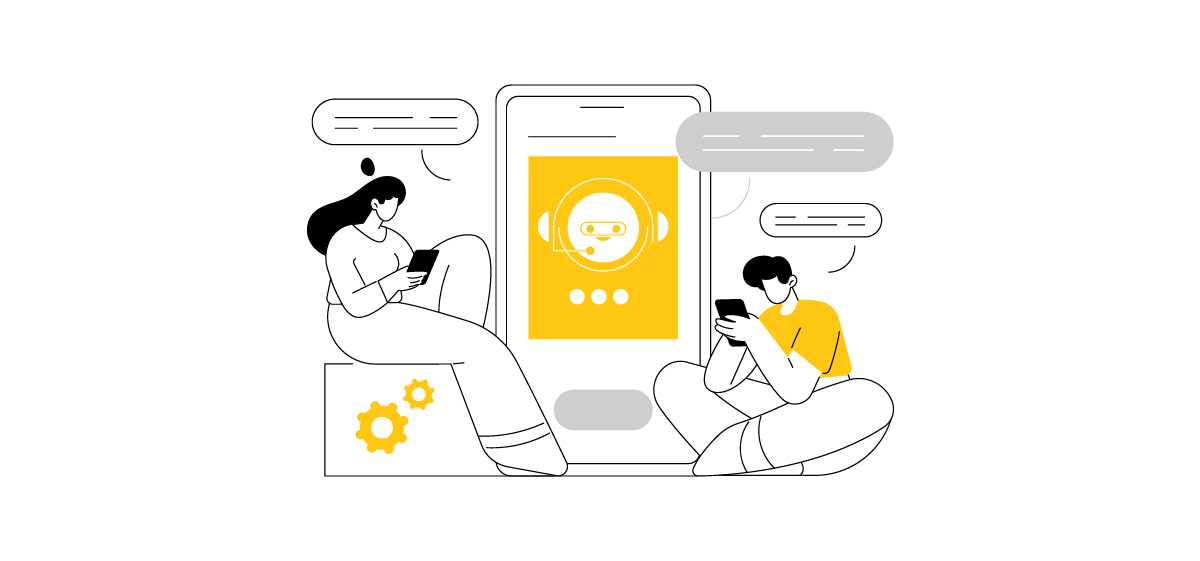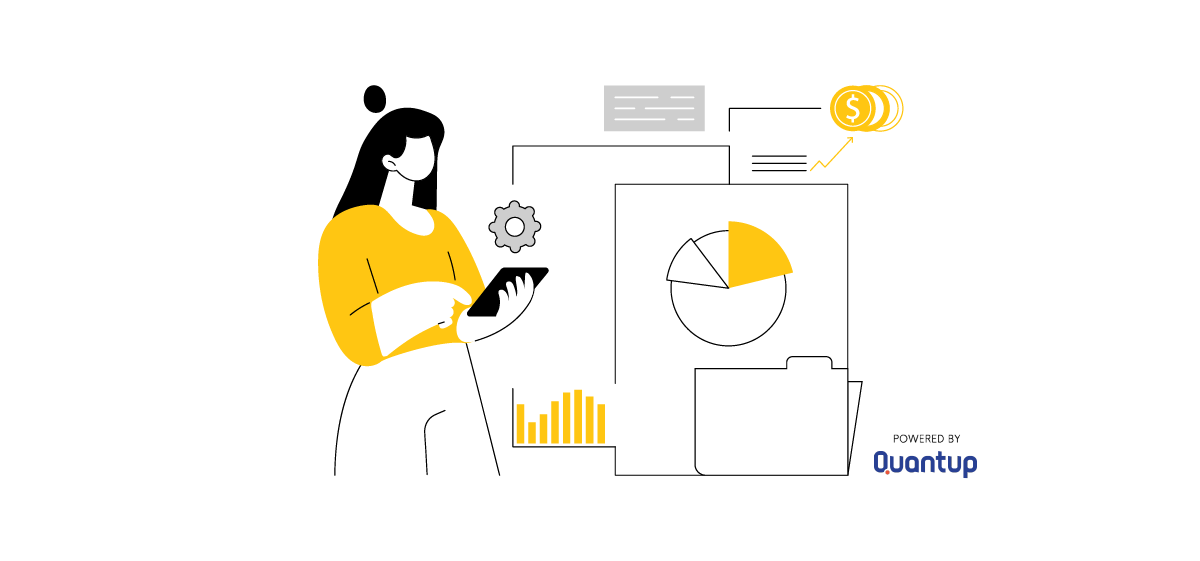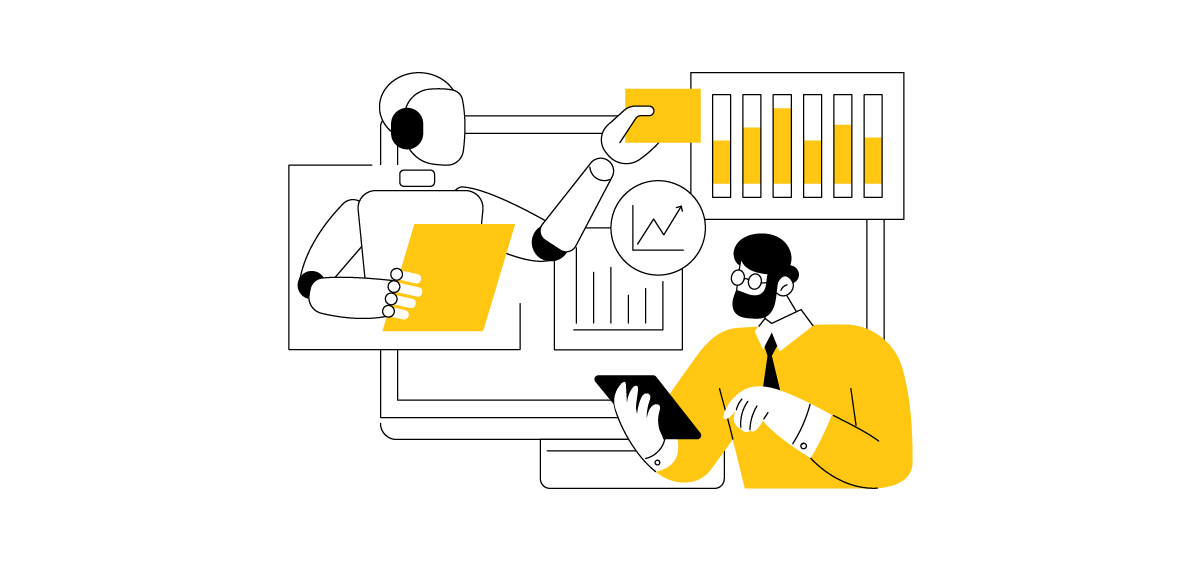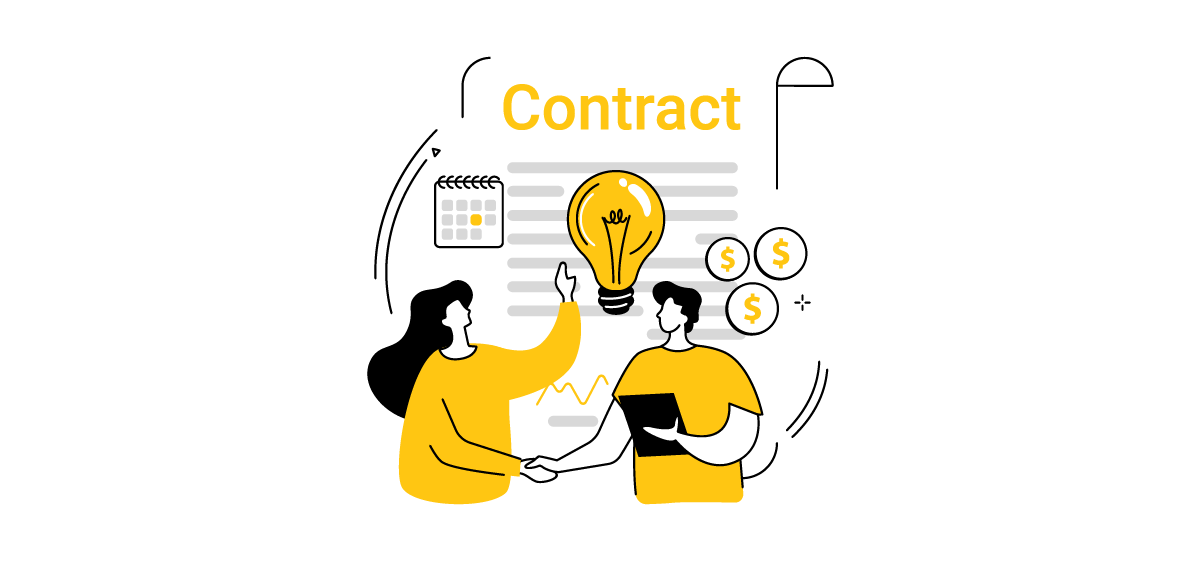
There comes a time during business development when we need to migrate applications. It is crucial in enterprise products that run under licenses or SLAs (Service-Level Agreements). An upgrade from Java EE to Jakarta EE may be required to meet these requirements. Are you ready for this?
Let’s consider what this change entails and whether it is a sensible move for your development projects or organizational goals.
Table of Contents
A brief history of Java EE and Jakarta EE
To fully understand Jakarta EE’s importance, it is necessary to understand the origins of its predecessor, Java EE. Developed by Sun Microsystems (later acquired by Oracle), Java EE, or Java Enterprise Edition, was a widely adopted platform for developing scalable and secure enterprise applications. It extended the capabilities of Java Standard Edition (Java SE) with a comprehensive set of APIs and specifications tailored for server-side development. After the mention of Java SE, it’s crucial to note that Java EE (now Jakarta EE) is part of the broader ‘java platform’ designed specifically for enterprise application development, encompassing a rich history, evolution, and a suite of technologies and APIs for developing and deploying robust enterprise applications.
Over the years, Java EE has become the foundation of many mission-critical systems, and it is known for its stability, maturity, and reliability. However, in 2017, Oracle announced that it would transfer control of Java EE to the Eclipse Foundation, a huge step that led to the creation of Jakarta EE.
The change was not just a rebranding but the beginning of a new era. Today, the industry is evolving toward native architectures for the cloud, microservices, and containerization, so Jakarta EE is evolving in this direction while providing a stable platform for existing Java EE applications.
The illustration below shows how the Jakarta EE and Java SE platforms are interconnected. The Java SE platform defines standards for the Java SDK, JRE, JVM, and JCL. Jakarta EE extends Java SE by defining a set of APIs tailored for enterprise application development.
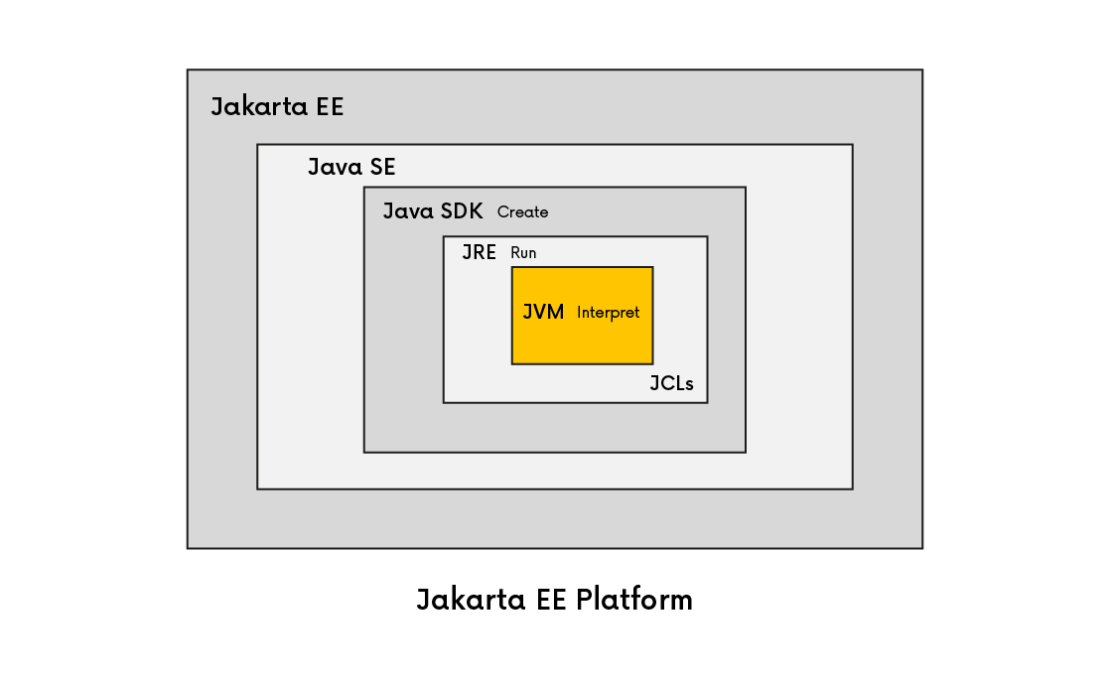
Key differences between Java EE and Jakarta EE
Although Jakarta EE and Java EE share a common heritage and are built on the same principles, they have some key differences. Under the stewardship of the Eclipse Foundation, Java EE technologies have seen significant evolution, adapting to modern enterprise needs by incorporating frameworks like Spring and Hibernate, and moving away from older technologies like EJBs in favor of more contemporary solutions such as Contexts and Dependency Injection for Java EE. Additionally, the transition to Jakarta EE has been closely monitored through the use of the Technology Compatibility Kit (TCK), which ensures that applications servers are compliant with the Java EE specifications by implementing all of its JSRs and passing all the tests on the designated TCK, a process that was crucial for the successful transfer of Java EE to the Eclipse Foundation.
Change in management and ownership
Java SE and Java EE were primarily managed by Oracle, with decisions and updates coming from a centralized body. At one point, Java EE was withdrawn from Oracle’s offerings, and its specifications were moved to the Eclipse Foundation. However, Oracle has reserved the use of Java expressions. Since then, Oracle has focused on Java SE.
In contrast, Jakarta EE is now managed by the Eclipse Foundation, which takes a more community-based approach. It manages dependencies such as Hibernate (JPA), Tomcat (servlets), etc. This change in management allows for greater transparency, collaboration, and integration in the development process.
Jakarta EE provides a link, so to speak, between traditional and modern technologies, enabling organizations to implement new technological advances while maintaining current investments in applications and infrastructure.
Naming convention
Java EE used a monolithic package naming scheme in which all specifications were preceded by the prefix “javax.” This naming convention reflected centralized control and ownership of the platform.
On the other hand, Jakarta EE is taking a more modular and extensible approach. APIs and specifications are now prefixed with “Jakarta,” reflecting the platform’s community and open-source nature. This modular approach allows for easier integration with other open-source projects and promotes interoperability.
The main change was the name of the service but not the classes associated with it. So, you might have been familiar with the previous naming of the Java JMS (Java Message Service) messaging service, which was transformed into the Jakarta Message service (Jakarta Message Service). Similarly, the Java Servlet Specs are now Jakarta Servlet Specs (Jakarta Servlet Specs). JDBC used to be a Java database connectivity; now, it is a Jakarta database connectivity.
Cloud development, microservices architecture, and dependency injection
While Java EE supported distributed computing and web services, Jakarta EE adopted cloud-native principles such as containerization and orchestration. This shift enables developers to create scalable, resilient, and portable applications that can run seamlessly in modern cloud environments. Additionally, Jakarta EE specifications provide robust support for generating web pages, operating with a database, and balancing processing efficiently, which is crucial for adapting enterprise applications to cloud-native architectures.
Summary of the differences between Java EE vs Jakarta EE
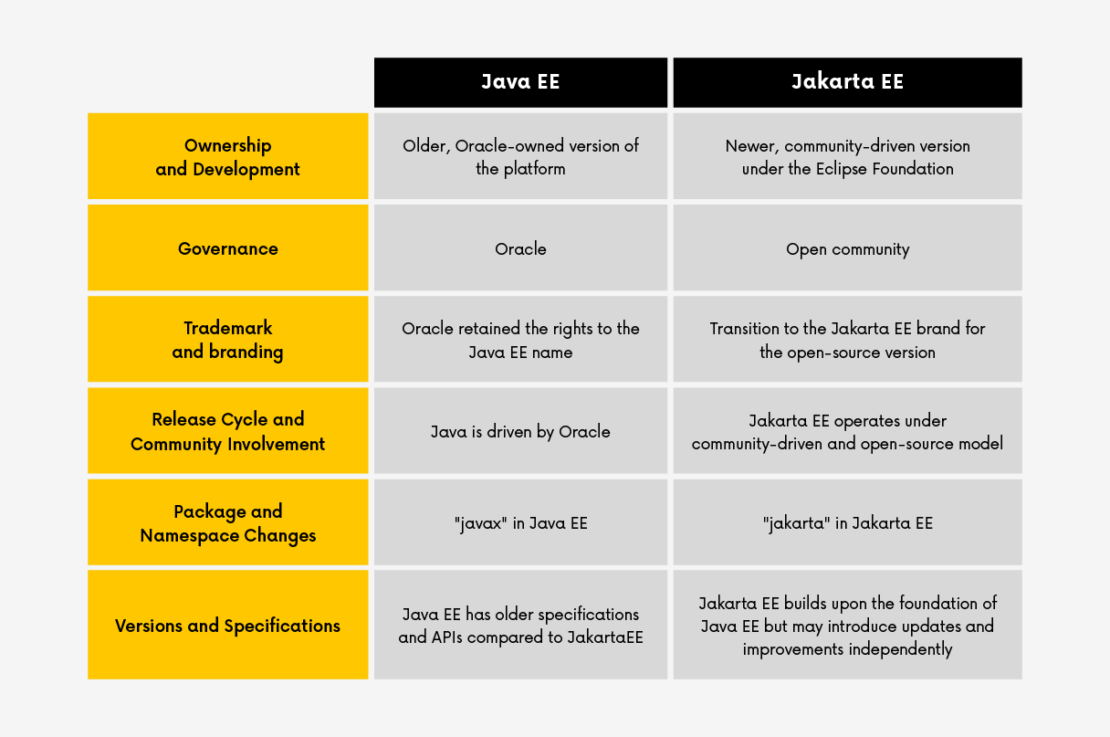
Benefits of using the Jakarta EE platform
Jakarta EE is a standard that many existing solutions work with products you may be familiar with – such as Jetty, Tomcat, Jersey, and Spring – all rely on Jakarta EE technologies. Jakarta EE is supported by various application server implementations, which are crucial for running enterprise applications that require robust, scalable, and secure environments. For example, Apache Tomcat implements the four Jakarta EE specifications: Spring Boot embeds Apache Tomcat, Eclipse Jetty, or Undertow as a runtime environment. An excellent example of technologies that also rely on Jakarta EE in their cloud-native enterprise Java applications are Eclipse Jetty, Eclipse IDE, MicroProfile, and other industry frameworks that implement MicroProfile(source: Jakarta.ee)
The transition from Java EE to Jakarta EE benefits Java developers.
- A more open development process
Because it is an open-source project, developers have a say in the direction of the platform and can actively contribute to its growth and evolution.
Integration with other open-source projects
The platform’s modular nature allows developers to mix and match components from different vendors, frameworks, and libraries, creating a more flexible and customizable development environment.
Java EE Compatibility
Existing Java EE applications can be very easily migrated to Jakarta EE, with a focus on maintaining compatibility. This allows companies to leverage their existing investments in Java EE applications and infrastructure while taking advantage of the new features and enhancements offered by Jakarta EE. Jakarta EE enables developers to enforce constraints on model classes through bean validation, enhancing application reliability by ensuring data integrity and consistency.
Long-term support
The Eclipse Foundation oversees the Jakarta EE platform and provides long-term support for its releases. It allows Jakarta EE users to receive updates, security patches, and bug fixes for a specified time, usually several years after the release.
Less restrictive license
Under the Eclipse Foundation, Jakarta EE has adopted a more liberal licensing structure for its specifications, known as the “Eclipse Foundation Specification License.” This license is less restrictive than the previous Java Community Process (JCP) licenses run by Oracle, allowing for easier compatibility and participation in Jakarta EE technology development.
Modularization and containers
Jakarta EE embraces a modular architecture, allowing the development of lighter and more efficient applications by selecting only the required components. This approach enables faster startups and better resource utilization.
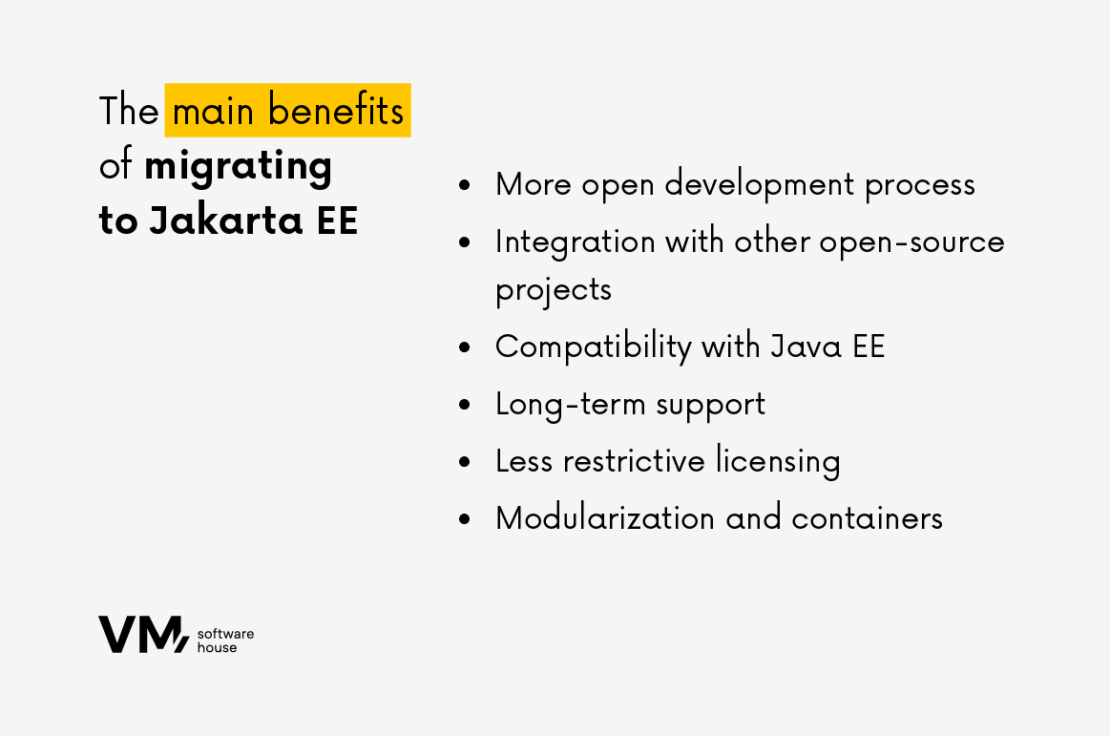
What should you look out for when applying for migration to Jakarta EE?
Jakarta EE version 10 was released on September 13, 2022, and is supported by Java SE 1 and Java SE 11. This begs the question: What challenges do developers face when it comes to migrating their own applications?
Migration to new package names
In such cases, of course, one is highly dependent on the specific migration plans of individual projects. As a rule, this is a simple task since it is all about names, so in the simplest case, the change is done by a simple search and replacement. Of course, this still requires adjusting the API version in pom.xml and changing the namespaces in the XML files. A big help in the migration process is to use IntelliJ, which, as indicated on the JetBrains site, heavily automates the process.
Compatibility
A more significant challenge arises when determining the level of compatibility between libraries and frameworks. While Jakarta EE maintains backward compatibility, there may be some differences in behavior and implementation in Java EE. For more on the role of Jakarta EE compatibility with numerous tools, see the official documentation.
Many projects use other frameworks or libraries packaged into their own applications. In some cases, they also use the Java EE or Jakarta EE API and are therefore affected by the migration problem. Interfaces such as javax.servlet.Servlet or javax.servlet.Filter, for example, is essential for many open-source libraries. It is necessary to thoroughly test and verify the migrated applications to ensure they work as expected.
This is important because not all users migrate to a new version of the platform at the same time, requiring them to support both old and new package names for at least some period of time. This can only be solved by maintaining two development branches in parallel.
Infrastructure assessment
In addition, it is critical to assess the migration’s impact on the overall architecture and infrastructure. Migrating to Jakarta EE may require updates to core architectures such as application servers, databases, and middleware. It is important to assess the compatibility of these components with Jakarta EE and plan for any necessary upgrades or changes. A holistic approach to migration ensures that all aspects of the application stack are considered and addressed.
Tools and resources for Jakarta development
A wide range of tools and resources are available to support developers in their transition to Jakarta EE. The Eclipse Foundation, Jakarta EE’s governing body, provides a comprehensive set of tools and frameworks that simplify the development process. Among the technologies that developers can utilize when building applications with Jakarta EE is Java Server Faces (JSF), highlighting the suite of specifications available for enterprise application development.
In addition to the reference implementation, several IDEs (integrated development environments) offer support for Jakarta EE development. Eclipse IDE, IntelliJ, IDEA, and NetBeans are some of the popular IDEs that provide features such as code completion, debugging, and deployment support for Jakarta EE projects.
The Jakarta EE ecosystem also includes many libraries, frameworks, and extensions that can streamline the development process. Jakarta EE-compatible frameworks, such as Spring, Hibernate, and Apache Tomcat, provide additional functionality and simplify everyday tasks such as dependency injection, persistence, and web development. These frameworks have extensive documentation and community support, making it easy for developers to get started and utilize their capabilities.
Companies that have successfully migrated their enterprise applications to Jakarta EE
Several companies have already implemented Jakarta EE for their enterprise Java development. One such example is IBM, a global technology company that offers a wide range of software and services. IBM has long been a supporter of Java EE and has made significant contributions to its development. With the transition to Jakarta EE, IBM continues to actively contribute to the community and use Jakarta EE in its enterprise applications.
Another example is Red Hat, a leading provider of open-source solutions. Red Hat is a strong advocate of open-source technology and has played a vital role in the development of Jakarta EE. It offers a range of products and services to support Jakarta EE, including its flagship product, Red Hat OpenShift, a container platform based on Kubernetes. Red Hat’s commitment to open-source principles aligns well with Jakarta EE’s goals, making it a natural partner in the ecosystem.
For a client in the logistics industry, VM.PL programmers created a project for a complete warehouse system for receiving goods, handling orders, and inventory. One of the challenges was to integrate the IT system with the existing legacy solution. This also required the VM.PL team could adapt the new software to the infrastructure and ensure seamless data migration. In the end, 2022 successfully migrated to Spring Boot 3.0, which also involved migrating packages to Jakarta EE.
If you want to learn more about migrating from Java EE to Spring, take a look at the article: “What are the benefits of replacing JavaEE with Spring?”.
What are the prospects for Jakarta EE?
The future of Jakarta EE looks promising as it continues to evolve and improve its platform. What’s more, the Jakarta EE community is actively working on new specifications, APIs, and tools to meet the changing needs of enterprise Java development. Some of the development directions include:
Development native for the cloud. The platform is being enhanced to better support containerization, microservices, and architectures native to the cloud. This includes improved integration with container orchestration platforms such as Kubernetes and support for cloud-native patterns and best practices.
Integrating emerging technologies such as artificial intelligence (AI) and machine learning (ML) into Jakarta EE. The Jakarta EE community is developing APIs and frameworks that simplify the integration of AI and ML capabilities into Jakarta EE applications.
Developer productivity and ease of use. Efforts are being made to simplify the development process, reduce standard code, and provide intuitive APIs and tools.
Will you migrate from Java EE to Jakarta EE in your enterprise?
As we mentioned in the article, migration to Jakarta EE is a significant opportunity for future-proofing enterprise applications. When and how to carry it out will certainly depend on the company’s specific needs, strategic direction, and resources.
However, as Mike Milinkovich, executive director of the Eclipse Foundation, mentions:
“Jakarta EE provides your company with two strategic benefits: a growth path for existing investments in Java EE application code serving your business and a bright future for the skilled Java developers employed on your team.”
If you are considering switching from Java EE to Jakarta EE, we encourage you to contact our experienced Java specialists. They’ll be happy to tell you more about how you can make a smooth transition to Jakarta EE, and they are confident that your enterprise applications will keep up with the changing technology and business landscape.










